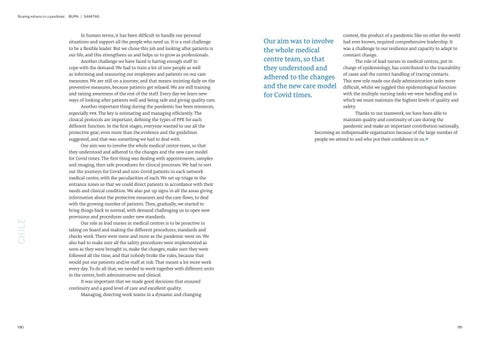CHILE
Bearing witness to a pandemic BUPA | SANITAS
190
In human terms, it has been difficult to handle our personal situations and support all the people who need us. It is a real challenge to be a flexible leader. But we chose this job and looking after patients is our life, and this strengthens us and helps us to grow as professionals. Another challenge we have faced is having enough staff to cope with the demand. We had to train a lot of new people as well as informing and reassuring our employees and patients on our care measures. We are still on a journey, and that means insisting daily on the preventive measures, because patients get relaxed. We are still training and raising awareness of the rest of the staff. Every day we learn new ways of looking after patients well and being safe and giving quality care. Another important thing during the pandemic has been resources, especially ppe. The key is estimating and managing efficiently. The clinical protocols are important, defining the types of PPE for each different function. In the first stages, everyone wanted to use all the protective gear, even more than the evidence and the guidelines suggested, and that was something we had to deal with. Our aim was to involve the whole medical centre team, so that they understood and adhered to the changes and the new care model for Covid times. The first thing was dealing with appointments, samples and imaging, then safe procedures for clinical processes. We had to sort out the journeys for Covid and non-Covid patients in each network medical centre, with the peculiarities of each. We set up triage in the entrance zones so that we could direct patients in accordance with their needs and clinical condition. We also put up signs in all the areas giving information about the protective measures and the care flows, to deal with the growing number of patients. Then, gradually, we started to bring things back to normal, with demand challenging us to open new provisions and procedures under new standards. Our role as lead nurses in medical centres is to be proactive in taking on board and making the different procedures, standards and checks work. There were more and more as the pandemic went on. We also had to make sure all the safety procedures were implemented as soon as they were brought in, make the changes, make sure they were followed all the time, and that nobody broke the rules, because that would put our patients and/or staff at risk. That meant a lot more work every day. To do all that, we needed to work together with different units in the centre, both administrative and clinical. It was important that we made good decisions that ensured continuity and a good level of care and excellent quality. Managing, directing work teams in a dynamic and changing
context, the product of a pandemic like no other the world had ever known, required comprehensive leadership. It was a challenge to our resilience and capacity to adapt to constant change. The role of lead nurses in medical centres, put in charge of epidemiology, has contributed to the traceability of cases and the correct handling of tracing contacts. This new role made our daily administration tasks more difficult, whilst we juggled this epidemiological function with the multiple nursing tasks we were handling and in which we must maintain the highest levels of quality and safety. Thanks to our teamwork, we have been able to maintain quality and continuity of care during the pandemic and make an important contribution nationally, becoming an indispensable organization because of the large number of people we attend to and who put their confidence in us.�
Our aim was to involve the whole medical centre team, so that they understood and adhered to the changes and the new care model for Covid times.
191































